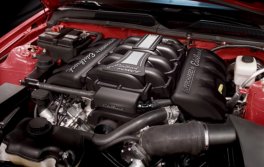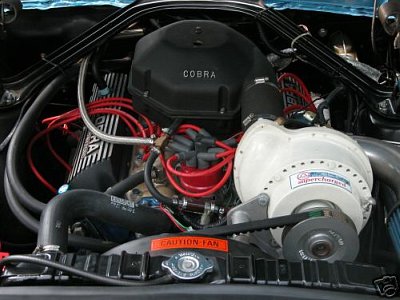|
A supercharged Mustang PrimerFor many of us, a beautiful supercharged Mustang would be the ultimate pony car to be seen sitting in the driveway. Supercharged Mustang BasicsYour stock V6 or V8 Ford Mustang can live a happy and long life with a supercharger attached, so long as you don't get too greedy. The pony car is blessed with strong internal components, but wasn't designed to be a race engine. That kind of punishment takes an engine rebuild designed for the substantially higher internal cylinder pressures generated by a blower. So can you realistically expect to add a supercharger to your Mustang for the street? Absolutely. But unless you're a good fabricator, you're going to have to dig deep to make it happen. What Kind of Power can You Expect?Blowers come in different sizes, all determined by how much additional air and fuel you can afford to stuff into the cylinders. The more air and fuel you can get into a cylinder in any given intake stroke, the more power you can potentially produce. A stock engine will probably hold another 100 to 150 or so horsepower, without tearing the engine down and building it specifically for supercharging. So your basic 300 horsepower engine climbs to upwards of 400 to 450 horsepower. Purpose built Mustang engines and cars built for the street and strip can push much higher boost pressures, which make over 600 to 800 horsepower a reality. Supercharged vs TurbochargedLike cars, many Mustang fans prefer a supercharger and others prefer a turbocharger. A turbocharger, while technically always making power, is dependent on how fast, exhaust gasses are spinning the turbo. At low levels, the turbocharger isn't spinning fast enough to produce any more air than the engine is already capable of pulling in by itself. When engine rpms increase under heavy throttle, exhaust gas pressure spins the turbo faster until the pressure is higher than normal and pushes additional air into the cylinders. The gap between mashing the gas pedal and getting full boost is known as "turbo lag". The advantage of a supercharger is instant on-demand power. Unless equipped with an electric clutch setup, a supercharger is always powered and producing more horsepower. What does a supercharger cost?Adding a blower (supercharger)to any car isn't cheap, but it's one of the easiest ways to make big horsepower without investing in huge changes to the engine. Expect to pay around $4,000 or more for a complete kit and half that if you are good at scrounging and fabrication. The good news, though, is that with only a pulley diameter change, a blower is still just as valuable if you decide in future that it's time for a higher performance engine build. More InformationIf you think a supercharged Mustang might just be what you need, finding a supercharger manufacturer with the right blower setup has never been easier. Check out the links below for more information. |






